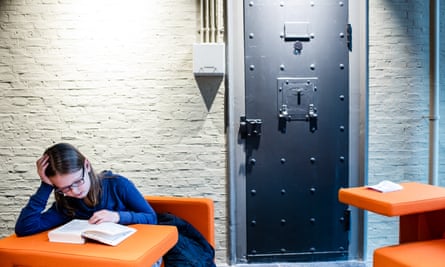It’s just after 10am and I’m cycling through the narrow cobblestone streets of Leeuwarden in the Netherlands, past canals with ivy-covered banks and perfectly preserved 17th-century merchant houses, thanks to Mila and her boyfriend Wilmar, our guides for the day. “Bike is by far the best way to see the city,” says Mila. “The only rule is you’ve got to bring us back afterwards. And in the same condition.”
Leen een Fries – in other words, borrow a Frisian – sums up the spirit of Leeuwarden. It’s a free scheme of 90-plus visitor experiences, where locals lend their time to show you the sights, help you find your way and offer tips. This year the city is joint European Capital of Culture (along with Valletta in Malta) and there’ll be lots of events to celebrate. Friesland, in the northwest of the Netherlands, is the most authentic, if unknown, of its provinces, full of meadows and forests; Leeuwarden, its capital, is like Amsterdam without the crowds. It has survived since the early 10th century on the dairy farms that surround it. Nowadays it’s a pastoral town with an enviable number of national monuments (600, to be precise), epicurean cheese shops (Zuivelhoeve on Kleine Kerkstraat is a particular treasure trove) and cycling lanes that are as civilised and effort-free as you’d expect.

We park up at Blokhuispoort, a 19th-century prison museum; with its gothic arch, high masonry and intimidating Wormwood Scrubs turrets, it doesn’t immediately feel that welcoming. It’s not until you get inside that you appreciate its transformation. The old courtyards have been completely converted – there’s a stylish youth hostel, a lively waterside restaurant called Proefverlof and a designer library (no portcullis, but Porridge-style cells double as wonderfully kooky reading rooms). On the ground floor is a bookworm’s haven, Café de Bak, but right now I’m in need of more sustenance and an hour alone with Dostoevsky isn’t going to do it.
Not far down the street is the Post-Plaza Hotel and Grand Café that Wilmar insists I visit following our tour. Vaulted and high-ceilinged, the brasserie was once the main post office and a haphazard array of antique mail boxes and letter trays are lovingly preserved. In keeping with the city’s flair for reinvention, the adjoining boutique hotel has redefined the architectural lines of a former bank. The highlight, after plates of buttery prawns and delicious North Sea bass, is a coffee paired with a hazelnut and aniseed dúmke, a biscuit – I’m told – shaped like a Frisian’s thumb.

To get a feel for Leeuwarden’s art credentials, the Fries Museum on Wilhelminaplein, centre of cultural life in the province, is the best place to start. The journey begins at street level with a minimalist café, before climbing, past views of Frisian flags hung from the Gerechtshof courthouse across the square, to the upper galleries where the past still seems tangibly and reassuringly present in the gallery exhibits. If you like your history with a side of QI trivia, the medieval De Oldehove tower, visible on the distant fringes of the old town, is far more extraordinary than Pisa’s leaning one; it’s so crooked it could never be finished.
Upstairs is an exhibition devoted to one of the town’s more famous former residents, Mata Hari, born into a prosperous Leeuwarden family in 1876. In 1917 she was convicted by the French of passing secrets to the enemy, accused of being the “greatest woman spy of the century” and executed by firing squad. She has now been cast in a different light, thanks in part to a cache of her personal letters published for the first time in 2017. It’s a fascinating exhibition, running until 2 April, followed by a retrospective on another former resident of Leeuwarden, MC Escher (from 28 April to 28 October). Lampooned by his peers, he nevertheless created some of the most memorable images of the 20th century with his mathematical dreamscapes; Stanley Kubrick and Mick Jagger were fans. As a warm-up for his arrival, the Phantom Limb exhibition (until 6 January 2019) features postmodern homages to this master of illusion.

It’s a short ride from here to where Escher was born, a building that now houses the Princessehof National Museum of Ceramics, spruced up for its centenary year. There’s not much evidence here of Escher’s vision until you look halfway up the brickwork, and there you can spot a homage; a glittering mural depicting a brain-bending tessellation of silver and black ducks. If Leeuwarden is nervous about its new cultural role, it certainly doesn’t show. Everywhere you look there are interesting creative projects that “fool around with established certainties”, as Escher put it, from the converted prison to Boomsma Beerenburger, a novel walk-in micro-distillery located a block from the ceramics museum where juniper, liquorice and sweet calamus are steeped in alcohol.
“Leeuwarden is ready for this party,” artist Dioni ten Busschen tells me over a glass of wild blackberry-infused spirits in the tasting room, showing a photograph of her most recent work, a life-size Friesian horse sculpted from peat. The European Capital of Culture’s imperative is to put a destination on the map, but it seems that Leeuwarden really didn’t need that much help at all. Or as the Frisians say, doe maar gewoon. Just act normal.
Way to go
EasyJet flies from 10 UK airports to Amsterdam Schiphol from £42 return; Leeuwarden is a 2¼-hour train ride north. Doubles at the WTC Hotel Leeuwarden from £70. For a free city tour, visit leeneenfries.nl. More information at holland.com and friesland.nl

Comments (…)
Sign in or create your Guardian account to join the discussion